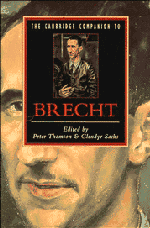Book contents
- Frontmatter
- PART 1 CONTEXT AND LIFE
- PART 2 THE PLAYS
- 3 Brecht's early plays
- 4 The Threepenny Opera
- 5 Brecht's clowns: Man is Man and after
- 6 Learning for a new society: the Lehrstück
- 7 Saint Joan of the Stockyards
- 8 The Zelda syndrome: Brecht and Elisabeth Hauptmann
- 9 The Good Person of Szechwan: discourse of a masquerade
- 10 Mother Courage and Her Children
- 11 Heavenly food denied: Life of Galileo
- 12 The Caucasian Chalk Circle: the view from Europe
- PART 3 THEORIES AND PRACTICES
- Bibliography
- Index of Works
- General Index
6 - Learning for a new society: the Lehrstück
from PART 2 - THE PLAYS
Published online by Cambridge University Press: 28 May 2006
- Frontmatter
- PART 1 CONTEXT AND LIFE
- PART 2 THE PLAYS
- 3 Brecht's early plays
- 4 The Threepenny Opera
- 5 Brecht's clowns: Man is Man and after
- 6 Learning for a new society: the Lehrstück
- 7 Saint Joan of the Stockyards
- 8 The Zelda syndrome: Brecht and Elisabeth Hauptmann
- 9 The Good Person of Szechwan: discourse of a masquerade
- 10 Mother Courage and Her Children
- 11 Heavenly food denied: Life of Galileo
- 12 The Caucasian Chalk Circle: the view from Europe
- PART 3 THEORIES AND PRACTICES
- Bibliography
- Index of Works
- General Index
Summary
The centrality of the Lehrstück (learning play) to Brechtian theory was only slowly understood by a wider circle of international, critical audiences. Whether it was the lack of a comprehensive theory dealing with these works, or the Cold War hangover that rendered their texts particularly unpalatable, the result was a more-or-less total misunderstanding of this group of plays written between 1926 and 1933. A prominent and influential example of misreading was Martin Esslin's interpretation of the learning plays in his book Brecht: The Man and His Work. It is significant that Esslin translated the term Lehrstück as 'didactic plays', because in his view Brecht was writing communist thesis if not propaganda plays. Not until 1972, when Reiner Steinweg published his first volume dedicated to the construction of a coherent theory of the Lehrstück, which Brecht had provided in fragments and sketches only, was the relation of the learning plays to the rest of Brecht's work fully appreciated.
- Type
- Chapter
- Information
- The Cambridge Companion to Brecht , pp. 79 - 95Publisher: Cambridge University PressPrint publication year: 1994
- 13
- Cited by

